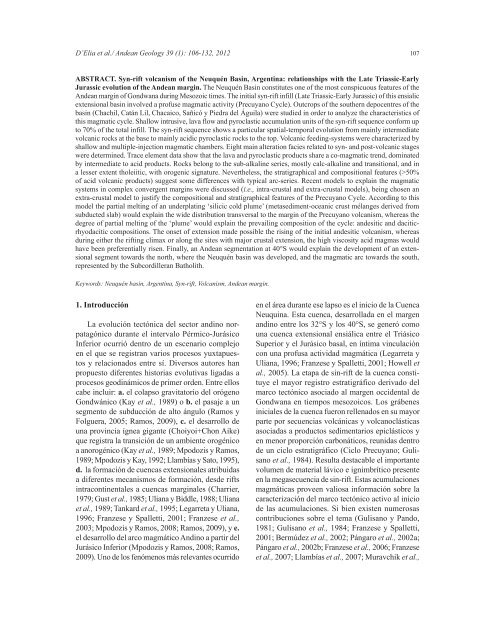Redalyc.Volcanismo de sin-rift de la Cuenca Neuquina, Argentina ...
Redalyc.Volcanismo de sin-rift de la Cuenca Neuquina, Argentina ...
Redalyc.Volcanismo de sin-rift de la Cuenca Neuquina, Argentina ...
Create successful ePaper yourself
Turn your PDF publications into a flip-book with our unique Google optimized e-Paper software.
D’Elia et al./ An<strong>de</strong>an Geology 39 (1): 106-132, 2012<br />
ABSTRACT. Syn-<strong>rift</strong> volcanism of the Neuquén Ba<strong>sin</strong>, <strong>Argentina</strong>: re<strong>la</strong>tionships with the Late Triassic-Early<br />
Jurassic evolution of the An<strong>de</strong>an margin. The Neuquén Ba<strong>sin</strong> constitutes one of the most conspicuous features of the<br />
An<strong>de</strong>an margin of Gondwana during Mesozoic times. The initial syn-<strong>rift</strong> infill (Late Triassic-Early Jurassic) of this ensialic<br />
extensional ba<strong>sin</strong> involved a profuse magmatic activity (Precuyano Cycle). Outcrops of the southern <strong>de</strong>pocentres of the<br />
ba<strong>sin</strong> (Chachil, Catán Lil, Chacaico, Sañicó y Piedra <strong>de</strong>l Águi<strong>la</strong>) were studied in or<strong>de</strong>r to analyze the characteristics of<br />
this magmatic cycle. Shallow intrusive, <strong>la</strong>va flow and pyroc<strong>la</strong>stic accumu<strong>la</strong>tion units of the syn-<strong>rift</strong> sequence conform up<br />
<br />
volcanic rocks at the base to mainly acidic pyroc<strong>la</strong>stic rocks to the top. Volcanic feeding-systems were characterized by<br />
shallow and multiple-injection magmatic chambers. Eight main alteration facies re<strong>la</strong>ted to syn- and post-volcanic stages<br />
were <strong>de</strong>termined. Trace element data show that the <strong>la</strong>va and pyroc<strong>la</strong>stic products share a co-magmatic trend, dominated<br />
by intermediate to acid products. Rocks belong to the sub-alkaline series, mostly calc-alkaline and transitional, and in<br />
<br />
of acid volcanic products) suggest some differences with typical arc-series. Recent mo<strong>de</strong>ls to exp<strong>la</strong>in the magmatic<br />
systems in complex convergent margins were discussed (i.e., intra-crustal and extra-crustal mo<strong>de</strong>ls), being chosen an<br />
extra-crustal mo<strong>de</strong>l to justify the compositional and stratigraphical features of the Precuyano Cycle. According to this<br />
<br />
subducted s<strong>la</strong>b) would exp<strong>la</strong>in the wi<strong>de</strong> distribution transversal to the margin of the Precuyano volcanism, whereas the<br />
<br />
rhyodacitic compositions. The onset of extension ma<strong>de</strong> possible the ri<strong>sin</strong>g of the initial an<strong>de</strong>sitic volcanism, whereas<br />
during either the <strong>rift</strong>ing climax or along the sites with major crustal extension, the high viscosity acid magmas would<br />
sional<br />
segment towards the north, where the Neuquén ba<strong>sin</strong> was <strong>de</strong>veloped, and the magmatic arc towards the south,<br />
represented by the Subcordilleran Batholith.<br />
Keywords: Neuquén ba<strong>sin</strong>, <strong>Argentina</strong>, Syn-<strong>rift</strong>, Volcanism, An<strong>de</strong>an margin.<br />
1. Introducción<br />
La evolución tectónica <strong>de</strong>l sector andino norpatagónico<br />
durante el intervalo Pérmico-Jurásico<br />
Inferior ocurrió <strong>de</strong>ntro <strong>de</strong> un escenario complejo<br />
en el que se registran varios procesos yuxtapues-<br />
<br />
propuesto diferentes historias evolutivas ligadas a<br />
procesos geodinámicos <strong>de</strong> primer or<strong>de</strong>n. Entre ellos<br />
cabe incluir: a. el co<strong>la</strong>pso gravitatorio <strong>de</strong>l orógeno<br />
Gondwánico (Kay et al., 1989) o b. el pasaje a un<br />
segmento <strong>de</strong> subducción <strong>de</strong> alto ángulo (Ramos y<br />
c. el <strong>de</strong>sarrollo <strong>de</strong><br />
<br />
que registra <strong>la</strong> transición <strong>de</strong> un ambiente orogénico<br />
a anorogénico (Kay et al.,<br />
<br />
d. <strong>la</strong> formación <strong>de</strong> cuencas extensionales atribuidas<br />
a diferentes mecanismos <strong>de</strong> formación, <strong>de</strong>s<strong>de</strong> <strong>rift</strong>s<br />
intracontinentales a cuencas marginales (Charrier,<br />
et al.,<br />
et al.,et al.,<br />
et al.,<br />
e.<br />
el <strong>de</strong>sarrollo <strong>de</strong>l arco magmático Andino a partir <strong>de</strong>l<br />
<br />
<br />
<br />
en el área durante ese <strong>la</strong>pso es el inicio <strong>de</strong> <strong>la</strong> <strong>Cuenca</strong><br />
<strong>Neuquina</strong>. Esta cuenca, <strong>de</strong>sarrol<strong>la</strong>da en el margen<br />
<br />
una cuenca extensional ensiálica entre el Triásico<br />
<br />
con una profusa actividad magmática (Legarreta y<br />
et<br />
al.,tuye<br />
el mayor registro estratigráfico <strong>de</strong>rivado <strong>de</strong>l<br />
marco tectónico asociado al margen occi<strong>de</strong>ntal <strong>de</strong><br />
Gondwana en tiempos mesozoicos. Los grábenes<br />
iniciales <strong>de</strong> <strong>la</strong> cuenca fueron rellenados en su mayor<br />
parte por secuencias volcánicas y volcanoclásticas<br />
asociadas a productos sedimentarios epiclásticos y<br />
en menor proporción carbonáticos, reunidas <strong>de</strong>ntro<br />
sano<br />
et al., 1984). Resulta <strong>de</strong>stacable el importante<br />
<br />
en <strong>la</strong> megasecuencia <strong>de</strong> <strong>sin</strong>-<strong>rift</strong>. Estas acumu<strong>la</strong>ciones<br />
magmáticas proveen valiosa información sobre <strong>la</strong><br />
caracterización <strong>de</strong>l marco tectónico activo al inicio<br />
<strong>de</strong> <strong>la</strong>s acumu<strong>la</strong>ciones. Si bien existen numerosas<br />
contribuciones sobre el tema (Gulisano y Pando,<br />
et al.,<br />
et al.,et al.,<br />
Pángaro et al.,et al.,<br />
et al.,et al.,et al.,

















